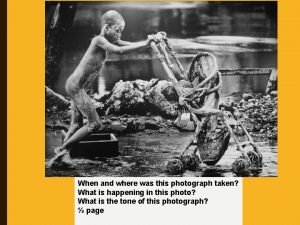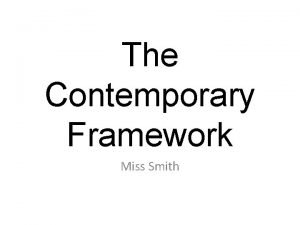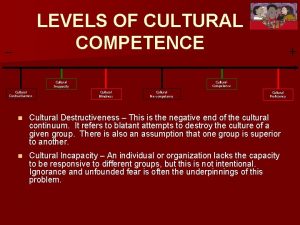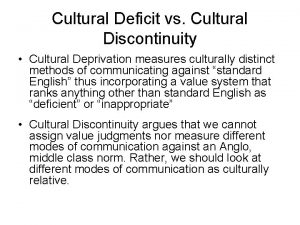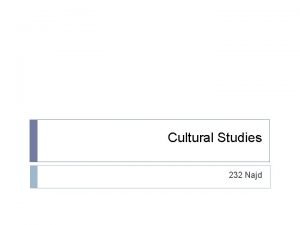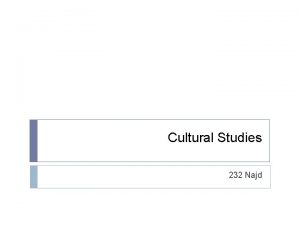The cultural Framework Miss Smith 2014 Notes taken

































































- Slides: 65

The cultural Framework Miss Smith 2014 Notes taken from 4 cats

The cultural Framework beliefs social Creative values CULTURE political religious The Cultural Framework

The cultural Framework Firstly – What does the artwork reveal about the cultural values and beliefs of a particular cultural group or sub cultural group? The Cultural Framework

The cultural Framework Secondly – What cultural influences affected the artist when he or she produced the artwork? The Cultural Framework

The cultural Framework Finally – How would the artwork have been perceived by viewers within the artist’s culture and time period? How does this vary from the perception of viewers from different cultures and/or time the artist’s culture and time period? periods? The Cultural Framework

Social rituals – Includes socially accepted rituals and rules within a culture which regulate the behavior of the members of the society and the ways individuals and groups relate to each other. – Often relate to religious traditions such as baptism and initiation of children into the culture, marriage and funerals and special religious events, i. e. Christmas, Easter, Ramadan and Passover. – Also relate to activities such as meeting people and developing friendships, social etiquette and leisure activities such as the participation in sporting, educational and political activities. The Cultural Framework

Social rituals • Depicting Dutch festivities for the Shrovetide festival, which is celebrated before the period of Lent began. • Lent involved sacrificing material pleasures and accordingly at Shrovetide people celebrated and feasted before the restrictions of Lent started. • This painting gives us vivid details of the food eaten, the musical instruments played and the rowdy nature of the entertainment. • Frans Hals captures the crude and rude actions that take place in local taverns. Hals, Merrymakers at Shrovetide, (1616 -17), The Cultural Framework oil on canvas 131. 4 x 99. 7 cm

Social rituals • Consider the following questions: – Are social rituals referenced in the artwork and what is the purpose and meaning of these rituals? – What relevance do these rituals have for the artist? – Do these rituals have any meaning or relevance for a viewer of the artwork living in 21 st century Australia or any other culture? – If so who are these people and why are these rituals still relevant to them? The Cultural Framework

Social structures and hierarchies – Include reference to the existence of social class or hierarchies within a particular cultural group, such as upper class vs. working class or rich vs. poor. – The opposite of a social hierarchy is a democratic or egalitarian culture where all members are equal and share social and political equality. Australia is generally considered to be relatively free of social class distinctions and is usually considered to be an egalitarian culture. England on the other hand has traditionally had a distinct class structure with royalty and nobility at its head. The Cultural Framework

Social structures and hierarchies Robertson Reid, Toil and Pleasure, (1879), oil on canvas 99. 1 x 182. 2 cm • The hierarchical structure of an English village is shown as dramatically polarised between those who work the land to live and those that use it for recreational purposes. • The weary workers stand to one side as members of the upper class engaging in one of their traditional pastimes of hunting, ride by in the distance. The Cultural Framework

Social structures and hierarchies E. Phillips Fox, Landing of Captain Cook at Botany Bay, 1770, (1902), oil on canvas 192. 2 x 265. 4 cm • We can see that Captain Cook is the leader and the social superior of the working seamen who do not wear shoes and are scurrying about doing the work. • The English naval system at the time of Captain Cook was notorious for this rigid class distinctions. The Cultural Framework

Social structures and hierarchies • Consider the following questions: – Are social hierarchies referenced in the artwork? – How can the viewer tell who is superior or inferior? – Does the artist’s own social class or position have any bearing on their representation of class hierarchies? – Does the artwork reference particular poverty within a society which is reflective of class divisions? – Is the artist mocking or critical of these class structures and divisions of wealth? The Cultural Framework

Religion and spirituality – A religious culture is one where the morals and values of the culture are shaped by a religion, such as Christianity, Islam or Buddhism. – In 16 th century Italy, the influence of the Roman Catholic Church was widespread and most Italians at the time would have been observant Christians. – Artworks which offend religious values are called blasphemous or heretical. The Cultural Framework

Religion and spirituality – Most religions have common themes such as devotion to God, compassion, charity, forgiveness, peacefulness and the prospect of eternal life of reincarnation. The Cross Is the symbol of Christianity The Star of David Is the symbol of Judaism The Star and Crescent Is the best known symbol used to represent Islam The Cultural Framework

Religion and spirituality – Artists often use their art as a way of criticizing or reinterpreting traditionally held concepts of religion. – Australian artists Luke Sullivan (1961) created controversy with the entry of his work The Fourth Secret of Fatima in the 2007 Blake prize. – It is a statue of the Virgin Mary, with her head and torso obscured by a blue burqua similar to the ones Afghan women had to wear under the Taliban regime. – Sullivan said he wanted to draw attention to the oppression of women in strict forms of religion, especially Islam. – Blasphemy: speech or actions which are considered insulting or disrespectful to sacred aspects of a particular religion. The Cultural Framework

Religion and spirituality • Consider the following questions: – Are specific religious or spiritual figures, events or religious values referenced in the artwork? – Is the artist using religious symbolism? – How have cultural influences affected the artist’s perception of religion? – How do you think the depiction of religion in the artwork would be perceived by a viewer of the artwork from 21 st century Australia or from another culture? The Cultural Framework

Work life – Work is an integral part of any culture and artist often depict or expose positive or negative aspects of that culture’s work life and expectations. The Cultural Framework

Work life Brack, Collins St 5 pm, (1956), oil on canvas 114. 8 x 162. 8 cm • Brack’s painting pictures grim faced office workers leaving the city in a monotonous line. • This painting is considered to be both an iconic painting of peak-hour Melbourne and a social commentary on daily working life in the 1950 s. • Each worker is unaware of the other, despite their close proximity. • It is a grim painting about the loss of individuality and a lack of social cohesion among the Australian masses. • The painting depicts emotionally closed office workers ground down by the grind of daily work. The Cultural Framework

Work life • Consider the following questions: – Are aspects of a culture’s work life or employment conditions referenced in the artwork? – Is working life depicted by the artist as valuable and uplifting? – Is work depicted in a negative or demanding way? – How do you think the depiction of work compares with working life and conditions of Australians in the 21 st century? The Cultural Framework

Politics/Power/government: – Politics is concerned with how individuals or groups of people have, or get power to exercise control and authority over others within their culture. The Cultural Framework

Politics/Power/government: – Artists may be protesting against the government’s attitude towards the environment. https: //www. youtube. com/watch? v=LOik. Du j. Ad. Tc The Cultural Framework

Politics/Power/government: – One way of adding meaning to political messages in artworks is the use of political symbols and the association of objects or events which create political symbolism for the viewer. The Cultural Framework

Politics/Power/government: • Andy Warhol created his Hammer and Sickle series of screen prints in 1976 after a trip to Italy where the most common graffiti in public spaces was the hammer and sickle, the symbol of communism. • Even though Italy was a democratic country, the repeated graffiti symbol of the hammer and sickle seemed to Warhol to be a form of decoration rather than as a political symbol. • In the USA the symbol was more political because it was symbol commonly used in American media to represent the Cold War between the Soviet Union and the USA. The Cultural Framework

Politics/Power/government: • Consider the following questions: – Are political events, kings, queens, tribal leaders or politicians or other heads of state references in the artwork? – Are they presented in a flattering way or a negative way? – Is the artwork making reference to a government action, policy or decision that affects people within a particular cultural group? – Is it a positive or negative reference? – Would a viewer from 21 st century Australia see any parallels with our political system? The Cultural Framework

Gender roles within a culture – Every artist is a member of a culture which will have certain perceptions of how men and women behave and the role each gender performs. – Until the 20 th century, in most western cultures being a loving mother and a dutiful wife were the highest aspirations a women could achieve. – Similarly in tribal cultures, women’s roles were focused on motherhood and domestic tasks. – Aggressive outspoken women were considered unnatural. – The male was considered to be more intelligent and worldly and the only gender capable of actively participating in religion, politics, war, business and the fine arts. Frida Kahlo, The Broken Column (1944) The Cultural Framework

Gender roles within a culture • For example in the painting of Captain Cook’s landing we see how the heroic act of exploring Australia was left to men only. Phillips Fox , Landing of Captain Cook at Botany Bay 1770 (1902) The Cultural Framework

Gender roles within a culture – Throughout art history women have been depicted as captives of a private world where they are inward-orientated towards the. – Depictions of a mother and child were commonly painted by artists and can be seen as an attempt to reinforce the role of women as mothers. Cindy Sherman, Untitled Film Still #3 (1977) The Cultural Framework

Gender roles within a culture The Madonna and Child is the symbolic term used for the frequent depictions of Mary with the baby Jesus, the pinnacle of a mother’s devotion to her child. The Cultural Framework

Gender roles within a culture • Dutch artist Johannes Vermeer (1632 -1675) is famous for painting the domestic worlds of women in 17 th century Netherlands. • Women were pictured in domestic environments, either as a maid or as a decorative wife, confined almost as if in a gilded cage. The Milkmaid (1658) Jan Vermeer The Cultural Framework

Gender roles within a culture On the Wallaby Track (1896) Frederick Mc. Cubbin • The active role of lighting the fire and boiling the billy on a journey outside the home is taken on by the male figure. • The women rest quietly with her child, creating an idealized and romantic image of The Cultural Framework motherhood.

Gender roles within a culture – Since the 1970’s with the rise of the Feminist movement, many artists, usually women turned their art to the goals of freeing women from the oppressions of a male-dominated culture. - In contemporary art, artists often present the symbols of female domesticity such as aprons, kitting and dressing gowns to make their point about gender imbalance. Cindy Sherman, Untitled Film Still #3 (1977) The Cultural Framework

Gender roles within a culture • Consider the following questions: – What does the artwork say about the accepted roles for women and men in the particular culture? – What does the artwork say about the balance of power between genders? – Is the artist challenging or presenting an alternative to culturally accepted gander roles or reinforcing accepted gender roles? – Is the artist using gender symbolism? – What would a viewer of 21 st century Australia say about the artist’s perception of the accepted roles for women and men in the particular culture and the balance of power between genders? The Cultural Framework

Sexuality and the cultural perception of Male and female beauty – In Classical Greek and Roman art, erotic images were frequently used, many of which portrayed love stories of their Gods. – Until recently most western cultures have not permitted the portrayal of sexual activity in artworks. – Such works are considered pornographic and were only available to a limited male audience. The Cultural Framework

Sexuality and the cultural perception of Male and female beauty Michelangelo, David (1504) • The perception of physical beauty varies within across time and across cultures. • For example, the Ancient Greeks had a tradition of representing the male body in sculptures as tall athletic and muscular. • Represented an idealized version of the society at the time, pure, strong and in control. • These figures were not based on real men but ideal versions of them. The Cultural Framework

Sexuality and the cultural perception of Male and female beauty Venus and Mars (1487/8) • Sexuality and the cultural perception of male and female beauty • Italian painted Sandro Botticelli (1445 -1510) portrays Venus, the goddess of love, lying opposite her lover Mars, god of war, who has fallen asleep apparently after making love to Venus • The women is not based upon a model but was the personification of beauty as he perceived it. No contemporary women would have had such perfect skin or such symmetrical features. • Both figures are an illusion, taking the best bits from many sources. The Cultural Framework

Sexuality and the cultural perception of Male and female beauty – The Male Gaze refers to the historically entrenched tradition of male artists producing artworks featuring nude or semi nude voluptuous and beautiful women for a primarily male clientele. Giorigone, Sleeping Venus (1510) The Cultural Framework

Sexuality and the cultural perception of Male and female beauty Sleeping Venus (1510) • The first female reclining nude in European painting is Giorigone’s The Sleeping Venus (1510). • It is one of the first modern works of art in which the female figure is the principal and only subject of the picture. • This innovation, pioneered by Giorgione, led directly to the work of artists such as Titan, Rubens and Goya. The Cultural Framework

Sexuality and the cultural perception of Male and female beauty The Cultural Framework

Sexuality and the cultural perception of Male and female beauty – In such works, the gaze of the female subject is often cast downwards, or turned away from her audience. – This is called a passive gaze. – Since the subject’s eyes don’t meet the viewer’s eyes, the viewer is free to play the role of the observer and examine her body at leisure. The Cultural Framework

Sexuality and the cultural perception of Male and female beauty – Even with portraits of actual people, Renaissance artists tend to ‘flatter’ their subjects by giving them attributes symbolising the beauty of the day – Bronzino was commissioned to portray an adolescent nobleman, possibly a young member of the Medici family, to whom Bronzino was court painter. Bronzino, Portrait of a Young Man (1550) The Cultural Framework

Sexuality and the cultural perception of Male and female beauty – The skin of the face is marble smooth, almost unthinkable in a teenager 450 years ago, and his hair is curled in the style of a Roman emperor’s statue. – The eyes, nose, and mouth are perfectly symmetrical and perfect. – The sitter was probably recognisable from the portrait, despite being physically enhanced. Bronzino, Portrait of a Young Man (1550) – Bronzino was able to adjust his image to suit his patron’s requirements, just as modern photographers use digital technology to make models thinner, and remove an extra chin and blemishes. The Cultural Framework

Sexuality and the cultural perception of Male and female beauty – Vermeer paints a women (possibly a wife and lady of the household) receiving a letter from a maid which suggests that she may be conducting a love affair outside the home. – This concept is quite subversive and counters the general stereotypical behaviour demanded of women that they remain faithful and chaste at all times to their husbands. – Interestingly the painting contains many symbols of infidelity which could not be perceived by viewers today. Vermeer, The Love Letter (1669) The Cultural Framework

Sexuality and the cultural perception of Male and female beauty – The mandolin on the women’s lap is symbolic of her playing herself love songs. – The seascape on the wall shows a rough sea which is symbolic of a stormy passion. – The women is seated near the fireplace which in Vermeer’s paintings symbolic of the fiery passion of love. – The broom by the door and the embroidery cushion on the floor symbolise a women who is neglecting the management of her household duties for an affair. Vermeer, The Love Letter (1669) The Cultural Framework

Sexuality and the cultural perception of Male and female beauty – Cindy Sherman (1954) was prominent in attacking stereotype ideas about female beauty. – Sherman created this series of photographic self portraits featuring herself as a centrefold. – This was a parody to the ‘cheesecake’ imagery of women in naked sexual positions used by men’s magazines such as Playboy. – Close-cropped and close up, they portray Sherman in a range of roles from sultry seductress to a frightened vulnerable victim who is being exploited. Sherman, Untitled #96 (1981) – As the photographer and engineer of the image, she is also the artist, gazing upon herself. The Cultural Framework

Sexuality and the cultural perception of Male and female beauty • Consider the following questions: – What does the artwork reveal about the artist’s cultural perception of what constitutes female and male beauty? – Does the artwork involve issues around the male gaze? – How is the artist’s cultural perception of what constitutes female and male beauty different from what mainstream Australian culture in the 21 st century perceives of as beautiful? The Cultural Framework

Sexuality and the cultural perception of Male and female beauty • Consider the following questions: – Does the artist depict sexuality and desire in the artwork? – Is this done through symbolic references or codes or is it more graphic? – Is the depiction likely to offend members of the artists culture at the time the artwork was produced? – How would a viewer of the artwork from 21 st century Australia respond to the work? The Cultural Framework

Cultural Identity – Most cultures have certain core beliefs about their culture which become part of a general social perception. – Australian cultural identity was traditionally based on the ethos of mateship and ‘a fair go’. – Within each culture there also stereotyped versions of what a person within that culture should be like. The Cultural Framework

Cultural Identity • Charles Meere (1890 -61) presents Australians as a healthy sun loving people enjoying the good life of the beach. • The painting symbolises the freedom and egalitarian nature of Australian Beach Party (1940) Charles Meere The Cultural Framework

Cultural Identity • Cultural Identity The bathers (1989) Anne Zahalka • Australian artist Anne Zahalka (1957), the daughter of a Czech father and Austrian mother who migrated to Australia in 1949, has explored themes of Australian cultural identity in her work. • In her famous photograph, The bathers (1989), she explores and challenges the mythology and stereotypes that have evolved around Bondi Beach as an icon of Australian cultural identity. The Cultural Framework

Cultural Identity • Zahalka was inspired by Charles Meere’s painting, Australian Beach Party (1940). But unlike Meere’s original, Zahalka chose people who reflected the multicultural nature of Australia in 1989. • The people chosen are not ‘individuals’ but generic types suggested that, as Australian society changes, and stereotypes that surround Australian beach life, also continues to evolve. • She includes people of Mediterranean origin and Eastern European origin. The bathers (1989) Anne Zahalka • If the photograph were taken today, it would include a wide variety of cultures. The Cultural Framework

Cultural Identity • Consider the following questions: – Does the artwork represent or reinforce a mythical or stereotypical aspect of a cultural identity? – Is the artist using cultural symbols to do this? – Is the artist challenging a cultural identity or trying to create a different version of cultural identity? The Cultural Framework

The representation of racial & Religious sub-cultures within a wider culture – Within most cultures there are sub-cultures based on racial or religious grounds such as the Aboriginal Culture within the broader Australian Culture. – History is full of examples of oppression of subcultures. – Domination and oppression can result within a culture where certain sub-cultures are marginalized on the basis of race, ethnicity or religion. – Alternatively, it can occur where one culture invades or colonizes another culture and imposes its own cultural values. The Cultural Framework

The representation of racial & Religious sub-cultures within a wider culture • The representation of racial and religious sub-cultures within a wider culture – The way an artist depicts a particular subculture within a wider community reveals something about the prevailing attitudes of that wider culture to that sub-culture. – Australian artist have often represented the way that Aboriginals have been treated as a sub-culture in the wider Australian culture. The Cultural Framework

The representation of racial & Religious sub-cultures within a wider culture • In Landing of Captain Cook at Botany Bay 1770 (1902) the two male Aboriginal figures are marginalized to the top of the painting. • In the mind of Phillips Fox and the wider culture in 1902 when the painting was painted, Aboriginals barely existed in the thoughts and minds of the wider community. • They appear passive and weak as if it is inevitable that they would be dominated by Europeans. • They offer no resistance to the colonising English. The Cultural Framework

The representation of racial & Religious sub-cultures within a wider culture • Yosl Bergner (1920) who lived in Australia from 1937 – 50 was the first artist to paint Aboriginals as victims of social injustice. • As a Jewish refugee from Nazi persecution, Bergner likened the fate of the Aboriginals in Australia to that of Jews under Nazism. • He often pictured Aboriginal people standing passively in gloomy city backdrops. • His view of Aboriginal Australians as outcasts in their own land was unusual at the time but became more prominent in the art world. Bergner, Group of Aborigines 1938 The Cultural Framework

The representation of racial & Religious sub-cultures within a wider culture • Australian Aboriginal artist Daniel Boyd (1982) is interested in reinterpreting Australian history from an Aboriginal perspective and a culture that has been dispossessed. • He is concerned with revealing the Eurocentric bias of paintings which represent the colonisation of Australia and he has produced as series of paintings that reinterpret romantic historical Australian paintings with post-colonial themes. • Boyd reframes these paintings to show they from the perspective of an Aboriginal who has been dispossessed. The Cultural Framework

The representation of racial & Religious sub-cultures within a wider culture Boyd, We Call Them Pirates Out Here (2006) • Boyd has appropriated E. Phillips Fox’s iconic Australian painting The Landing of Captain Cooks at Botany Bay 1770 (1902). • Boyd critiques and parodies Fox’s painting, highlighting broader issues related to posy-colonialism and postmodern art practices. • From a post-colonial perspective We Call Them Pirates Out Here mimics the content and composition of Fox’s painting, however, the artist has added personal references and alternative symbols, changed imagery and compositional elements. The Cultural Framework

The representation of racial & Religious sub-cultures within a wider culture Boyd, We Call Them Pirates Out Here (2006) • Pirate symbols, such as the artist’s ‘Jolly Jack’ flag, a fusion of the British Union Jack and Jolly Roger pirate flag and Captain Cook’s eye patch, reference stolen wealth and violence. • A parrot sits both on the shoulder of Captain Cook and the figure to his left as a symbol of piracy. • Boyd has replaced the faces of the historical figures with those of personal acquaintances to locate his presence in the picture (not as an “other”. • In the far right background, two native Australian ‘black boy’ grass tress replace the Aboriginal men in Fox’s painting. • Whilst dark, turbulent clouds surround these figures in Fox’s painting, Boyd has shifted them to loom above Captain Cook’s tall ship as a symbol of Framework The Cultural

是亚文化所代表的艺术作品? The representation of racial & Religious sub-cultures within a wider culture • Consider the following questions: – Are sub-cultures being represented in the artwork? – If so what do you think the sub-cultures reveal about the broader culture's attitudes to the subculture? – Is the artist a member of a sub-culture? – How has that affected his or her perception of culture? The Cultural Framework

Cultural differences between artists And viewers – The way a viewer responds to an artwork depends heavily on the cultural background, education and values of that viewer compared with those of the artist. – It also depends on the historical context of the viewer compared with that of the artist. – Cultural differences usually arise in relation to art when the artist is presenting sexuality, religion or politics in a way which some viewers find offensive. The Cultural Framework

Cultural differences between artists And viewers • In certain cultures there will be an attempt to censor art which does not meet the government’s ideals and philosophies. • The most classic example of this is the Nazi government's labeling of some Expressionist art as degenerate. • In 1937 in Munich the Nazis held an art exhibition of what they called Degenerate Art. • The purpose of this exhibition was to let the Germans know that some forms and pieces of art were not accepted by the ‘highest race’, and this art was ‘degenerate’ largely because it was considered to be inspired by Jewish or Communist influences. The Cultural Framework

Cultural differences between artists • And viewers What one culture may find acceptable or meaningful as art could be completely unacceptable or meaningless to viewers from another culture. • Whilst Manet’s Olympia (1863) is freely exhibited in France, it would not be permitted to be exhibited in a public gallery in Iran where images of nudity are forbidden to be shown in public. The Cultural Framework

Cultural differences between artists And viewers • In historical times certain objects had different cultural meanings which would probably be meaningless to a contemporary viewer without further instruction. • The Arnolfini Marriage (1434) by Jan van Eyck (1935 -40), is a classic example of Renaissance symbolism in art. • The bride to be has placed her right hand into the left hand of her fiancé to symbolize their intention to wed. • The dog symbolizes love and fidelity, a pair of white slippers in the lower left symbolizes the sanctity of marriage, fruits on the windowsill symbolizes fertility and original sin, a candle burning in daylight acknowledges faith in God as well as his all-seeing eye. The Cultural Framework

Cultural differences between artists And viewers • Consider the following questions: – Did the artwork cause controversy within the artist’s culture at the time it was created? Why was this? – Would it cause controversy in Australia in 21 st century? – Does the artwork reference cultural meanings or messages which may be meaningless to the average Australian viewer now? The Cultural Framework

Cultural differences between artists And viewers • Consider the following questions: – Does the artwork reference cultural meanings or messages from a past time that are no longer appropriate in Australia now such as, outdated gender roles or using women for the male gaze? – Does the artwork reference cultural meanings and messages that may be acceptable to an average Australian viewer now but not in another culture? The Cultural Framework
 © jessica hall (miss señorita) 2014
© jessica hall (miss señorita) 2014 Jessica hall miss senorita 2015
Jessica hall miss senorita 2015 Libros de jessica hall
Libros de jessica hall Jessica hall (miss señorita) 2014
Jessica hall (miss señorita) 2014 Jessica hall (miss señorita) 2014
Jessica hall (miss señorita) 2014 © jessica hall (miss señorita) 2014
© jessica hall (miss señorita) 2014 Caf abbreviation
Caf abbreviation Aboriginal cultural standards framework
Aboriginal cultural standards framework What is figueroa's framework
What is figueroa's framework Cultural framework terpstra and sarathy
Cultural framework terpstra and sarathy Wisc
Wisc Dispositional framework vs regulatory framework
Dispositional framework vs regulatory framework Conceptual framework definition
Conceptual framework definition Conceptual research examples
Conceptual research examples Conceptual framework theoretical framework
Conceptual framework theoretical framework Dispositional framework vs regulatory framework
Dispositional framework vs regulatory framework Theoretical framework example
Theoretical framework example Hình ảnh bộ gõ cơ thể búng tay
Hình ảnh bộ gõ cơ thể búng tay Ng-html
Ng-html Bổ thể
Bổ thể Tỉ lệ cơ thể trẻ em
Tỉ lệ cơ thể trẻ em Gấu đi như thế nào
Gấu đi như thế nào Chụp phim tư thế worms-breton
Chụp phim tư thế worms-breton Chúa yêu trần thế
Chúa yêu trần thế Môn thể thao bắt đầu bằng từ đua
Môn thể thao bắt đầu bằng từ đua Thế nào là hệ số cao nhất
Thế nào là hệ số cao nhất Các châu lục và đại dương trên thế giới
Các châu lục và đại dương trên thế giới Công của trọng lực
Công của trọng lực Trời xanh đây là của chúng ta thể thơ
Trời xanh đây là của chúng ta thể thơ Cách giải mật thư tọa độ
Cách giải mật thư tọa độ 101012 bằng
101012 bằng Phản ứng thế ankan
Phản ứng thế ankan Các châu lục và đại dương trên thế giới
Các châu lục và đại dương trên thế giới Thể thơ truyền thống
Thể thơ truyền thống Quá trình desamine hóa có thể tạo ra
Quá trình desamine hóa có thể tạo ra Một số thể thơ truyền thống
Một số thể thơ truyền thống Cái miệng nó xinh thế chỉ nói điều hay thôi
Cái miệng nó xinh thế chỉ nói điều hay thôi Vẽ hình chiếu vuông góc của vật thể sau
Vẽ hình chiếu vuông góc của vật thể sau Nguyên nhân của sự mỏi cơ sinh 8
Nguyên nhân của sự mỏi cơ sinh 8 đặc điểm cơ thể của người tối cổ
đặc điểm cơ thể của người tối cổ Ví dụ giọng cùng tên
Ví dụ giọng cùng tên Vẽ hình chiếu đứng bằng cạnh của vật thể
Vẽ hình chiếu đứng bằng cạnh của vật thể Fecboak
Fecboak Thẻ vin
Thẻ vin đại từ thay thế
đại từ thay thế điện thế nghỉ
điện thế nghỉ Tư thế ngồi viết
Tư thế ngồi viết Diễn thế sinh thái là
Diễn thế sinh thái là Dot
Dot Các số nguyên tố là gì
Các số nguyên tố là gì Tư thế ngồi viết
Tư thế ngồi viết Lời thề hippocrates
Lời thề hippocrates Thiếu nhi thế giới liên hoan
Thiếu nhi thế giới liên hoan ưu thế lai là gì
ưu thế lai là gì Khi nào hổ con có thể sống độc lập
Khi nào hổ con có thể sống độc lập Sự nuôi và dạy con của hươu
Sự nuôi và dạy con của hươu Hệ hô hấp
Hệ hô hấp Từ ngữ thể hiện lòng nhân hậu
Từ ngữ thể hiện lòng nhân hậu Thế nào là mạng điện lắp đặt kiểu nổi
Thế nào là mạng điện lắp đặt kiểu nổi When and where was this photograph taken?
When and where was this photograph taken? 22 taken van de brandweer
22 taken van de brandweer If past perfect would have
If past perfect would have The road not taken theme
The road not taken theme The road not taken poem summary
The road not taken poem summary The road not taken figurative language
The road not taken figurative language The road not taken figurative language
The road not taken figurative language



























































